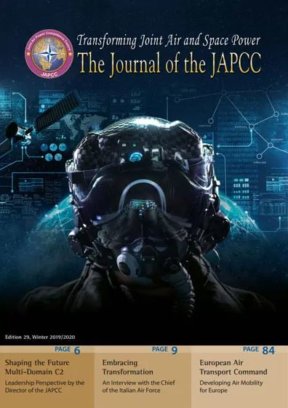Introduction
The lessons learned from the conflicts in Ukraine and Syria provide a unique insight into the complexity of conducting military operations in a congested and contested Electro-Magnetic Spectrum (EMS). Even though the term ‘spectrum’ is well understood by the majority, it is the Electro-Magnetic Environment (EME) which best captures the message NATO tries to convey when it comes to operating, exploiting, transmitting and receiving, or sending electromagnetic energy in time and space. In this vein, NATO nations have agreed to define EME1 as all of the electromagnetic phenomena occurring in a given place. Phenomena more than radio frequencies are better aligned with the essence of EME.
Freedom of movement and action in the EME have until recently been commonly accepted as a prerequisite for military operations. Success in modern military operations depends on making the most effective and efficient use and exploitation of the EME. NATO forces will operate within an increasingly complex and challenged EME2 in the future, therefore NATO should articulate proper procedures for the complex and unexpected EME Environment of the future.
For a long time, NATO accomplished different lines of activity to ensure freedom of movement in the EME, where a loss of control will inevitably lead to mission failure. Many forums call for consideration of the spectrum as a battlefield since it has significant influence in the aptitudes and procedures of the other domains (land, maritime, air, cyberspace and cognitive3). These domains must inexorably work within the spectrum to accomplish their missions effectively.
Ukraine and Syria provide good examples and a greater understanding of this new form of conflict. It was unveiled as a new facet of armed conflict, which can be labelled as ‘hybrid’ or ‘new generation’ with EW as a key capability in paradigms. The rationale behind the Russian Federation’s use of the EME in Ukraine and Syria was part of a larger strategy and one of the cornerstones of its Electronic Warfare (EW). Since the Georgian conflict (2008)4 the Russian EW techniques are taking surprising turns when it comes to the electromagnetic battlefield.
This period saw the development of a new confrontation environment with the EME and its associated operations – Electro-Magnetic Operations (EMO). In 2007 NATO promulgated a concept5 with the purpose to prepare for the transformation of the future electronic war. EMO was one of the cornerstones of this concept.
In the transformation document, NATO declared the EME as an operational environment, but not a domain. The EME cuts across all levels of warfare and must therefore be taken into account for the conduct and planning of every single operation. EMO models and exploits the EME, using it to attack or defend and includes the use of EME as supporting operations in all other operational environments (e.g. spectrum management and Position, Navigation & Time [PNT]). The challenge with NATO’s transformation of future electronic war – was and is the communications strategy internally across the wider EMO community. Some communities (and individuals) have a high appreciation of the need to transform whereas other communities/capability groups are sticking to a ritual manifested approach to using the EMS.
The Technology
The advancement of technology is a guarantor of global economic growth and progress, both of which are directly related. The availability of technology increases and sustains a higher quality of life. That same progress continues at a frenetic pace and does not always allow us to adequately determine new weaknesses and vulnerabilities. Therefore, protection against these vulnerabilities may be lacking since it requires additional investment. In summary, as technology progresses without suitable precautions the vulnerabilities of our security systems increase in direct proportion.
A good example is the interconnectivity that the Global Positioning System, the infamous Global Navigation Satellite System (GNSS)6 relies upon. GNSS, in addition to providing accurate positional data, also provides a global synchronized timing signal, crucial to the correct functioning for a multitude of modern technologies, this is a clear societal, commercial and military vulnerability.
Smart grids are on the rise as well, which basically incorporate digital technology to establish direct communication between customer and user. The system utilizes software tools to increase the efficiency of overall electricity consumption. The key is to provide an effective grid steering to the volatile demands of electricity and ultimately improve energy efficiency across the regional power grid area.
Recently, the National Institute of Standards and Technology published a report describing Smart Grid dependency to the timing provided by the GNSS7. It should be noted, that the disruption, denial and deprivation of a GNSS signal is surprisingly simple to accomplish. The first stage analysis on many online search engines reveals procurement of short-range GNSS jammers for no more than EUR 60. Far from being a chimera, this situation is real and GNSS denial operations are with us right now.
Smart Grids are nothing more than an example of the type of vulnerability associated with the fast-paced advancement of technology. GNSS denial or exploitation is also an example of the consequences of not paying correct attention to the EME. From a strategic point of view, these vulnerabilities were also highlighted in the recently release report8 by London economics about the potential loss of money due to GNSS disruption.
These vulnerabilities should encourage deep strategic, conceptual and doctrinal changes, by observing the latest and current conflicts and their subsequent developments. It may be necessary to build a new security and defence architecture in the face of changes to the strategic panorama that reveals so many important vulnerabilities, of which a large number are EME related.
Global Commons
Global Commons emerged as a major policy issue in the defence community when it comes to the safeguarding of national interests. Global Commons is not a new concept though as Admiral Alfred T. Mahan spoke in 1987 about the maritime environment being a Global Common9. Mahan envisioned the main mission of naval power to be keeping the maritime lines of commercial and own military passage open and to prevent access and use by adversary forces. At that time, maritime power was the driving force of the United States. For Mahan, that power arose from a process whereby all the social, political and military-economic forces were aligned and integrated.
The United Nations and the European Union define Global Commons as natural spaces beyond national jurisdictions10. Global Commons are spaces that need to be used freely by the countries because the economy is heavily dependent on them. The laws pertaining to Global Commons are generally agreed upon, but, as a rule, they are not binding commitments or it is difficult to enforce them.
Ensuring free access to common spaces is one of the priorities of NATO nations. Without access, the social model could be compromised, because common spaces allow for guaranteed transit of goods, services and information. The high seas, international airspace, outer space, and cyberspace are modern global commons interlinked through the EME and are critical to the prosperity and security of the Alliance nations. Access to these domains is a military and economic necessity in today’s world11.
This is why NATO nations’ national security strategies emphasize the importance of Global Commons and call for multilateralism to assure free access to them. Unfortunately, disruption of a Global Common is easy to perform.
NATO declared the four Global Commons12: air, space, maritime and cyber. Other entities choose ‘the atmosphere’ instead of ‘air’. When it comes to translating the civilian term of atmosphere into the military sphere, NATO omitted an essential part of that Global Common, namely the EME. The same spectrum overlaps all other Global Commons; all utilize it and interconnect in a symbiotic manner.
The Global Commons are closely linked to globalization, which demands interconnectivity between them to provide high standards of living or societies. The disruption of a Global Common has impact on the other domains and can have economic, social and geopolitical consequences. The interactions between the four Global Commons do not multiply the complexity, but rather elevate it exponentially.
There is a strong debate supporting the inclusion of the EME as a Global Common, especially based on events in recent conflicts in Ukraine and Syria. The Russian Federation’s exploitation of the spectrum puts NATO forces at a disadvantage in such congested and contested scenarios. The Global Commons enjoy the use of the EME without mitigating the vulnerabilities that access implies.
The EME has all the characteristics of being a Global Common. It is a global area with little regulation, it is vital for the economy and it is therefore necessary to protect it. The Global Commons are where the world trade occurs, denying their use would result in devastating consequences for the economy of any country.
Western countries are aware of the vulnerabilities of the Global Commons. For several years they have been trying multilaterally to maintain and guarantee access to the Global Commons. However, for some years, as witnessed most recently in Syria and Ukraine, the Russian Federation is increasingly able to affect the opposition forces freedom of movement in the EME. The Russian Federation’s mastery of EW is putting some NATO Nations’ armed forces at risk when it comes to the disruption of the Global Commons.
New Nature of Conflicts
Although it is not possible to predict with absolute certainty what the future will be like in terms of conflicts, it is extremely likely that Global Commons will play a central role in the geopolitical arena since the impact of a Global Common disruption on national economies is potentially catastrophic. Hybrid warfare bases its strength on exploiting vulnerabilities without escalating the crisis. The technology and its associated vulnerabilities have become more readily available, affordable and easy to exploit, not only to states but also non-state actors.
Problems arise when actions are taken (not necessarily military) to prevent persons, organizations or even nations from freely accessing Global Commons, normally by exploiting weaknesses in the security structures of western states using evolving technologies such as EW. In scenarios heavily influenced by adversaries’ EMO, accomplishing a single military action may be difficult since the aggressions routinely occur below NATO’s Article 513 threshold and the United Nations Security Council may be unable to agree on a Resolution to authorize the use of force.
Furthermore, the opportunity to employ EMO actions may provide added value in modern conflicts since it offers the option to respond with non-kinetic actions. As mentioned before, degrading or disrupting a Global Common may be easy to conduct utilizing EMO, but accurate or timely responses are frequently difficult to achieve since attribution can be difficult to prove. NATO needs to acknowledge that the EME rules the Global Commons and conceptualize and structure its capabilities towards this notion.
This scenario is already known and well described in the Allied Command Transformation (ACT) NATO Framework for Future Alliance Operations14 (2018). In fact, EW superiority is a main recommendation for NATO forces if the organization wishes to remain fit for purpose through the foreseeable future.
Conclusions
The changing security environment is complex and challenging for NATO. Recent lessons identified the requirement to pay more attention to the EME. Economies are largely dependent on unobstructed access to Global Commons. In the era of globalization, there are many resources shared with the entire globe. Furthermore, the Global Commons contain an infinite potential with regard to the advancement of the biology and society of all life, hence they require absolute protection.
To cope with this threat, strong alliances and partnerships are key and more important than ever. NATO should continue to play its role in supporting nations to address these threats through enduring cooperation and collaboration.
NATO is finally placing a priority on efforts and effects in the EMO realm. These endeavours should enable NATO to offer the proper response to the current threats posed by the Russian Federation, especially in keeping the Global Commons open for all countries. NATO’s continued prioritization on efforts and effects in the EMO will enable NATO nations to be ready to counter any aggression within a contested EME.









